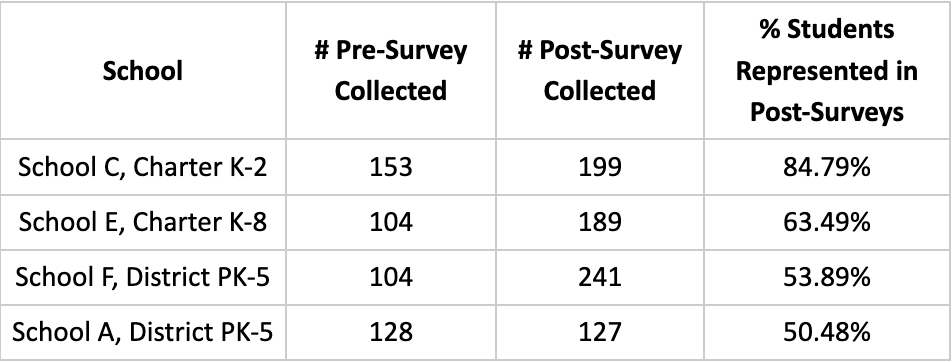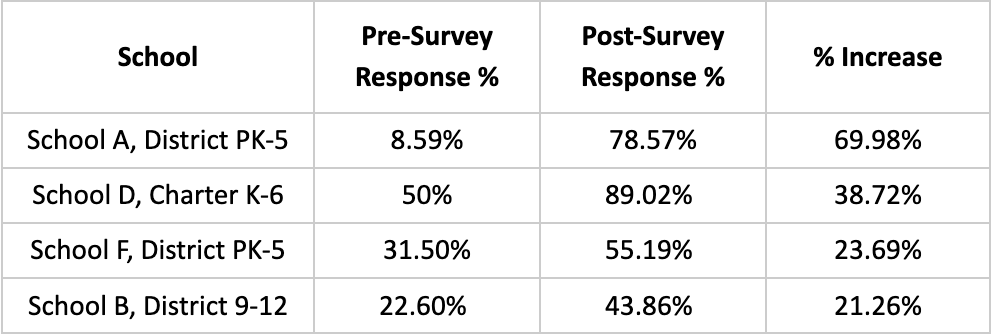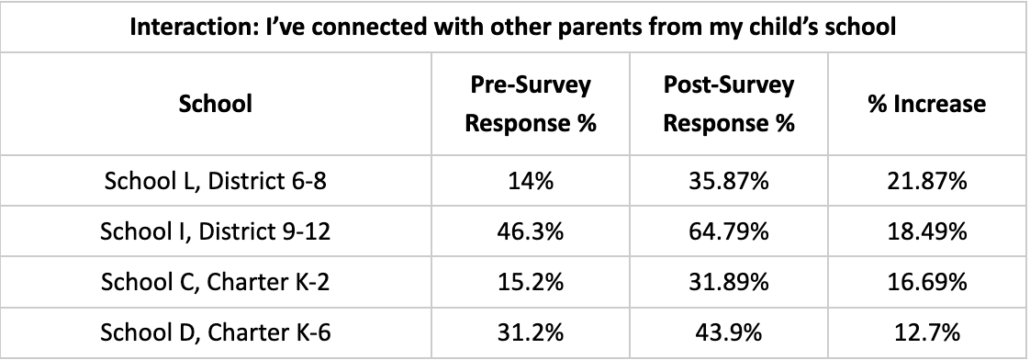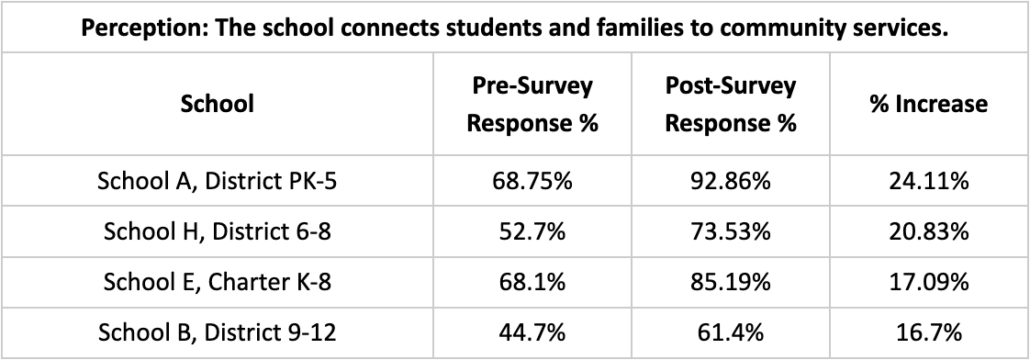#72 – Reflections from the 2021-22 School Year and Best Practices
Written by Jia Lin-Bothe, Family Empowerment Associate
It’s been a little over half a year since I joined the SchermCo team full-time, supporting the family empowerment work. During this time, I’ve helped our 12 partner schools co-create solutions based on the top needs of their families. One of the main reasons I enjoy this work so much is that I can connect families with resources, many of these being community support systems I wished I was aware of when I was growing up.
This past school year, we’ve collected 3,501 surveys. I was incredibly proud of the 1,456 post-surveys collected from May to June that helped track the growth of the family empowerment initiatives SchermCo has been supporting for the past five years. Here are some of my takeaways from the survey distribution and collection process:
- Start the survey collection process early! We saw that schools that started their survey distribution process in early May had more success than schools that started survey collection at the end of May. Next year, we hope to work with our partner schools to begin this process as early as April.
Communicate with families the school’s goals on survey response rates. Some schools in our cohort set ambitious goals, asking for upwards of 60% return rates. These schools met and exceeded their goals because they were hungry for feedback. Here are some of our schools with the highest survey return rates:

- WestEd found that the average response rate for district-sponsored paper surveys is 30%, and response rates in high schools and high-need schools are typically lower than that.
Create friendly competitions amongst students and homerooms. Students will ask their families to complete and return surveys in hopes of winning a pizza party for their homerooms. There are budget-friendlier ways for this, including dress-down day, free time, a popsicle party, etc.
- Take advantage of events where families show up at the end of the school year, like moving-up ceremonies and awards ceremonies, and have paper surveys and pens ready for families to complete during wait times.
- One of our school partners suggested we best meet the needs of families by calling them to receive feedback. We piloted this strategy at two schools and saw that families picked up the phone when they saw it was the school’s caller ID. Also, families were more likely to complete the survey over the phone when we asked if they could kindly take about five minutes out of their day to provide us with feedback about their student’s schools.
- Most of these phone calls took place during the school day, and we did get feedback from a couple of families who were at work that they wanted to provide input but couldn’t on the spot. We learned it was best practice to ask these families when it would be the best time to reach back out to them. This way, we can honor both their time and feedback.
- Coincidentally, we received more paper surveys than digital surveys/Google Forms. Out of the 1,456 post-surveys our school partners collected from May to June, an estimated 340 surveys, or 23.3%, were submitted digitally. Hence, we will be continuing to help with printing these surveys for our partner schools to ensure that families have the opportunity to provide feedback. We’ve also recognized that it would be helpful to help our schools sort these surveys so that each student takes a survey home.
Specifically, on survey results:
There was an average increase of 10.4% in families reporting they’ve attended a school event. Here’s more on the school-specific data:

- The data from school-specific pre-surveys allowed us to understand the days and times that families were most likely to participate in school events. Additionally, giving families advanced notice of events was crucial. On a side note, the RSVP system was beneficial from the planning aspect so that families could request transportation, and we knew how much food to order.
- Other areas of increased engagement included connecting with other families, advocating for their students, and providing feedback to the school. This is positive as it shows that families are comfortable expressing their concerns and believe the school will do something about it. Here’s more on the data:

- Likewise, many areas saw increases in the perceptions section. This included families expressing that their student’s school connects them to community services, expanded learning opportunities, and that the school will connect them to someone who can help them when they can’t help. This is incredibly impactful, as family and community engagement increases students’ likelihood of learning and thriving. Here’s more on the data:

- As for areas for growth, we saw a decrease in families attending a parent-teacher conference with their student’s teachers, so we will encourage our partner schools and teachers to hold conferences. This is especially helpful to our family empowerment initiatives, as it allows families to hear first-hand from their student’s teachers about academic progress and be informed about their student’s strengths, needs, behaviors, and learning styles. Additionally, families can get resources from teachers on how they can best support their student’s learning needs at home.
- Some of our partner schools had a strong presence of parents and guardians as part of their Family Empowerment Committees (FECs). Thus, involvement and engagement from families increased at these schools. Another area that we will be focusing on is encouraging and inviting more families to join the Family Empowerment Committee. We are setting an initial goal of having at least two families be a part of the Family Empowerment Committee at each partner school. Doing so will allow us to co-create solutions with families, for families to learn more about how school systems work, and show them ways to advocate for their students and other students’ success in school.
Other reflections:
- Many of our partner schools have a strong presence of Spanish-speaking and Hispanic families. However, only a few had success in these families completing the post-surveys. Moving into the next school year, we will focus on helping all of our partner schools to better engage with non-English speaking families. We will continue to help with translations and getting interpretation services at family-focused events. We already have plans to help one of our partner schools launch language and culture-specific family support groups.
- We succeeded in supporting one of our partner schools with school-wide professional development sessions to arm them with best practices and techniques for family engagement. We hope to not only have a more significant presence at our partner schools next year but also to support their staff further with professional development sessions, such as partnership mindset, positive communication strategies and systems, inviting families to engage, delivering excellent customer service, and elevating connections with non-English speaking families.
- We partnered with our schools to host 34 family-focused events this year. Out of these, the financial literacy series (6 workshops) were non-school specific. Moving into next year, we’d like to encourage more cross-collaboration between schools when planning family-focused events.
We’re looking forward to the upcoming school year and hoping to support at least 20 schools with our family empowerment services. More to do, more to come.
—
Action Steps:
- Check out our Family Empowerment webpage for data from the 2021-2022 school year.
- Check out our most recent video about our family empowerment work and efforts.
- Is your school interested in partnering with us in the upcoming school year? We’d love to chat about how we can support you, your staff, students, and families.
- Things to keep in mind when planning for family-focused events:
- Make sure to communicate with families at least two weeks before the event date so they can plan ahead.
- Communicate in multiple ways: phone calls, text messages, emails, etc. For returning families, consider asking the students’ teachers from the previous school year to invite these families.
- Put together a welcome packet for families that include the school’s contact information, school calendar, and other important information.
- Make sure there are interpreters to support the event.
- Collect feedback from families and ask what they want to see from the school.
